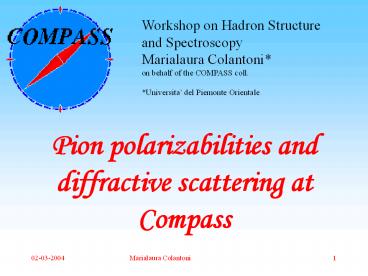Pion polarizabilities and diffractive scattering at Compass - PowerPoint PPT Presentation
Title:
Pion polarizabilities and diffractive scattering at Compass
Description:
Workshop on Hadron Structure and Spectroscopy Marialaura Colantoni* on behalf of the COMPASS coll. *Universita del Piemonte Orientale Pion polarizabilities and ... – PowerPoint PPT presentation
Number of Views:40
Avg rating:3.0/5.0
Title: Pion polarizabilities and diffractive scattering at Compass
1
Pion polarizabilities and diffractive scattering
at Compass
Workshop on Hadron Structure and
Spectroscopy Marialaura Colantoni on behalf of
the COMPASS coll. Universita del Piemonte
Orientale
2
Compass physics program
3
Outline
- Two objectives of the hadron program
- Primakoff reaction ? Z ? ? Z ?
- ? pion polarizabilities
- Diffractive scattering ? p ? (? ?) p
- ? search for exotic particles
4
The polarizability
The polarizability (electric ? and magnetic ?)
relates the average dipole (electric and
magnetic ) moment to an external
electromagnetic field.
q
q-
The polarizability is a quantity which
characterizes a particle like its charge, radius
.
5
The ?PT
- LQCD (quark,gluon) ? at low energy? Leff
(?,?,?,p,n..) - The ?PT provide a rigorous way to determine
??, ?? via the effective chiral lagrangian
The numerical values are
U. Burgi, Phys.Lett. B 377 (1996) 147
Consistent with the chiral simmetry
6
Polarizability measurements
- Photon Photon collision
- ?? (2.2 1.6statsys) 104 fm3 1
- Pion Photoproduction
- ?? (2012stat) 104 fm3 2
- Primakoff reaction
- ?? (6.8 1.4stat 1.2sys) 10-4 fm33
- ?? (-7.1 2.8stat 1.8sys) 10-4 fm3
- (?? ?? ) (1.4 3.1stat 2.5sys) 10-4 fm3
4
- 1 J. Boyer et al., Phys. Rev D 42 (1990) 1350,
P. Babusci et al., Phys. Lett. B 277 (1992) 158 - 2 T.A. Aibergenov et al., Cezch J. Phys B36,
948 (1986) - 3 Yu M. Antipov et al., Phys. Lett. 121 B
(1985) 445 - 4 Yu M. Antipov et al., Z. Phys. C 26 (1985) 495
7
The Primakoff reaction
?, p1
?, p1
For the reaction ? Z ? ? Z ? one measures
the Primakoff cross section
s1 ( p1 - k )2
?
?, k
?, k
- photon energy in the antilab system
Z, p2
Z, p2
t ( p2 p2 )2
? real photon scattering angle
8
The goals
- Pbeam 190 GeV/c to increase the ratio
- of the coulombian/nuclear cross section
- and less multiple scattering effect
- GOALS
- measure independently (?? ??), ??
- enough statistics
- to get the statistical errors negligible
- versus the systematic one
- evaluate systematic errors due to
- different cuts
- more complete angular distribution
9
The COMPASS hadron setup 2004
First Spectrometer LAS Geometrical Acceptance
?gt30 mrad Gap 172 ? 229 cm2 Integral field 1
Tm Analyzed momentum plt60 GeV/c
Second Spectrometer SAS Geometrical Acceptance
?lt30 mrad Gap 200? 100 cm2 Integral field 4.4
Tm Analyzed momentum pgt10 GeV/c
10
Trigger
y
Hodoscope (96 ?80)cm2
Beam Counter
x
Target
?-
?-beam z
?
beam
Veto system
SM2
SM1
ECal2 (128 ?256)cm2
Trigger Hodoscope ? ECal2
?-
?
11
Simulation shows 5
Resolution of transversal components of the
four-momentum transfer of (??)
5 Colantoni, Future Physics at COMPASS, 27-29
Sept 2002
12
The efficiency Nrec/ Ngen
Constant efficiency vs t
13
Comparison with the Serpukhov data
_at_ Serpukhov _at_COMPASS
beam momentum 40 GeV/c 190 GeV/c
beam intensity 106??/spill 107??/spill
target Be, C, Cu, Fe C, Cu, Pb
scattered pion ?? ? 1.2 10-4 rad ?? ? 4 10-5 rad
?p/p?1 ?p/p?(0.3?1)
outgoing photon ?? ? 1.5 10-4 rad ?? ? 3.1 10-5 rad
?E/E?3.5_at_27GeV ?E/E?(5.5/?E 1.5)
total flux 1011 1013 ?/day
Primakoff events 6103 in total 6.4 104/day
14
Primakoff summary
- Different target ? Z2 dependence in the
- the cross section
- Possible comparison with point like particle
- via the reaction ? Z ? ? Z ?
- Constant efficiency on t
- t resolution ? 5 10-4 (GeV/c)2
- Error on polarizabilities (syst. stat)
- ?? ? 0.4 10-4 fm3 (??theory)
- Also kaon polarizabilities can be measured
15
The exotic state .
- Hybrids
- quantum number not accesible for conventional
mesons - Problem ? lightest exotic state (mass 1.8 ?1.9
GeV/c2) 6 are in a mass region populated by
conventional mesons - 6 Barnes et al. Phys. Rew D 52 (1995) 5242
16
Experiments searching for exotic resonance
structure (1-) in ?? system
Exp massMeV widthMeV reaction
BNL6 1370 50 385 100 ?-p???-p
CBar7 1400 20 310 70 pn???-?0
CBar8 1360 25 220 90 pp???0?0
VES9 1316 12 287 25 ?-Be???-Be
Theory10 1900 200
6 Chung et al. Phys. Rev. D 60 (1999) 092001
7 Abele et al. Phys. Lett B423 (1998) 175 8
Abele et al. Phys Lett B 446 (1999) 349 9
Dorofee et al. The JPC 1- hunting season at
Ves Hadron Spectroscopy IX Int. Conference pp
143-154 10 N. Isgur et al. Phys. Rev. Lett. 54,
869 (1985)
17
Hybrid at COMPASS via
- Diffractive scattering (t lt 1 (GeV/c)2)
- ?p ?(Hybrid) p???p
b 6.5 (GeV/c)-2 for H target b 400
(GeV/c)-2 for Pb target
A PWA of diffractively produced system shows that
two partial waves are significant JP 2
produced a2(1320)-meson (wave D) JP 1- exotic
quantum number (wave P)
18
Simulation shows 10
- Flat reconstruction efficiency in D and P wave
- Mass resolution ?(M) 6 MeV/c
- Small dependence of ?(M) on the mass of hybrids
- Expected events for hybrids
- Na2???5K/day NP ??? 0.25K/day
10 Dorofee, Future Physic at COMPASS, 27-29
Setp. 2002
19
Summary Outlook
- Primakoff reaction to test the ?PT
- measuring the pion polarizabilities.
- Measurement of the kaon polarizabilities
- is also possible
- COMPASS can contribute to the search for hybrids
measuring the shape of 1- resonance































